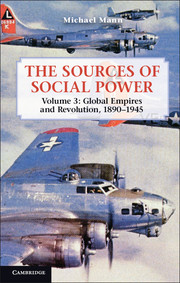Book contents
- Frontmatter
- Contents
- Preface
- 1 Introduction
- 2 Globalization imperially fractured
- 3 America and its empire in the Progressive Era, 1890–1930
- 4 Asian empires
- 5 Half-global crisis
- 6 Explaining revolutions
- 7 A half-global crisis
- 8 The new deal
- 9 The development of social citizenship in capitalist democracies
- 10 The Fascist alternative, 1918–1945
- 11 The Soviet alternative, 1918–1945
- 12 Japanese imperialism, 1930–1945
- 13 Explaining the Chinese revolution
- 14 The last interimperial war, 1939–1945
- 15 Conclusion
- Bibliography
- Index
13 - Explaining the Chinese revolution
Published online by Cambridge University Press: 05 November 2012
- Frontmatter
- Contents
- Preface
- 1 Introduction
- 2 Globalization imperially fractured
- 3 America and its empire in the Progressive Era, 1890–1930
- 4 Asian empires
- 5 Half-global crisis
- 6 Explaining revolutions
- 7 A half-global crisis
- 8 The new deal
- 9 The development of social citizenship in capitalist democracies
- 10 The Fascist alternative, 1918–1945
- 11 The Soviet alternative, 1918–1945
- 12 Japanese imperialism, 1930–1945
- 13 Explaining the Chinese revolution
- 14 The last interimperial war, 1939–1945
- 15 Conclusion
- Bibliography
- Index
Summary
In Chapter 6, I discussed the first Marxist revolutionary wave inspired by the Bolshevik Revolution in Russia. Apart from Russia itself, this wave was a failure, only provoking a more severe counterrevolutionary wave installing fascist and other rightist despotisms. The second wave was more successful. Again, it swept outward from a single revolution, of the Chinese Communist Party (the CCP). In 1949, after an epic thirty-year struggle punctuated by many defeats and much suffering, the CCP conquered the whole of mainland China and established itself over the most populous nation on earth. That government still endures today. I seek to explain this, the most significant revolution of the twentieth century, which was to provide the most successful alternative to Western capitalist democracy. I begin with narrative and end revisiting theories of revolution. I repeat my definition given in Chapter 6: a revolution is a popular insurgent movement transforming radically and violently at least three of the four sources of social power. The struggle and the achievements of the CCP easily meet these criteria.
Early trials and tribulations
The CCP had begun in the most modern part of China, around Shanghai and Guangzhou, as a normal Marxist party with an intellectual leadership provided by students and teachers and a rank and file of urban workers – especially skilled workers; the left wing of the KMT did better among the unskilled. Through the 1920s, the CCP remained small but committed to Marxist-Leninist conceptions of class and anti-imperialism, convinced by the success of the Bolsheviks that history was on their side. They too were salvationists. Soviet Comintern agents advised them. They had to adapt to the local situation, because China was very different from Russia. Shanghai workers retained their ties to their rural birthplaces, clan, ethnic and linguistic groups, guilds, and the pervasive secret societies of China. The Communists recruited through these diverse networks (Perry, 1993; S. Smith, 2000; Dirlik, 2003).
- Type
- Chapter
- Information
- The Sources of Social Power , pp. 398 - 422Publisher: Cambridge University PressPrint publication year: 2012



